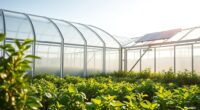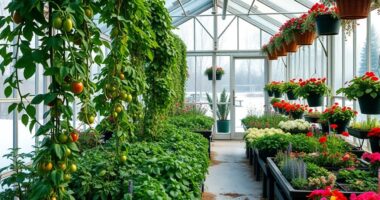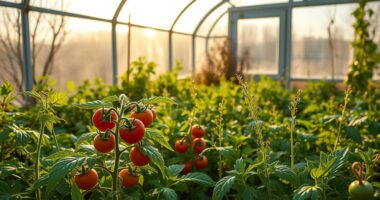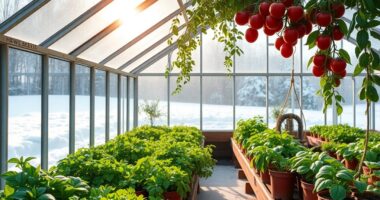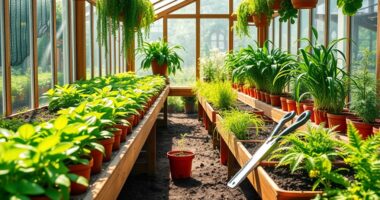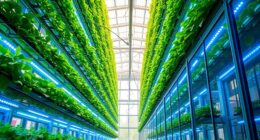Starting spring greenhouse gardening lets you get a jump on seedlings, flowers, and early vegetables. With climate control systems, you can maintain the perfect temperature and humidity, ensuring healthy growth and quick germination. Hydroponic setups help you grow robust plants faster without soil. This controlled environment extends your gardening season, allowing for earlier harvests and vibrant blooms. Keep exploring how these advanced techniques can transform your spring gardening success.
Key Takeaways
- Use climate control systems to maintain optimal warmth and humidity for seedlings, flowers, and early vegetables.
- Set up hydroponic systems for faster growth and robust seedlings indoors before outdoor planting.
- Extend the growing season by starting plants early inside the greenhouse, ensuring healthy development.
- Manage light exposure and airflow to promote vibrant blooms and prevent disease.
- Create a protected environment to reduce weather-related setbacks and ensure consistent crop production.
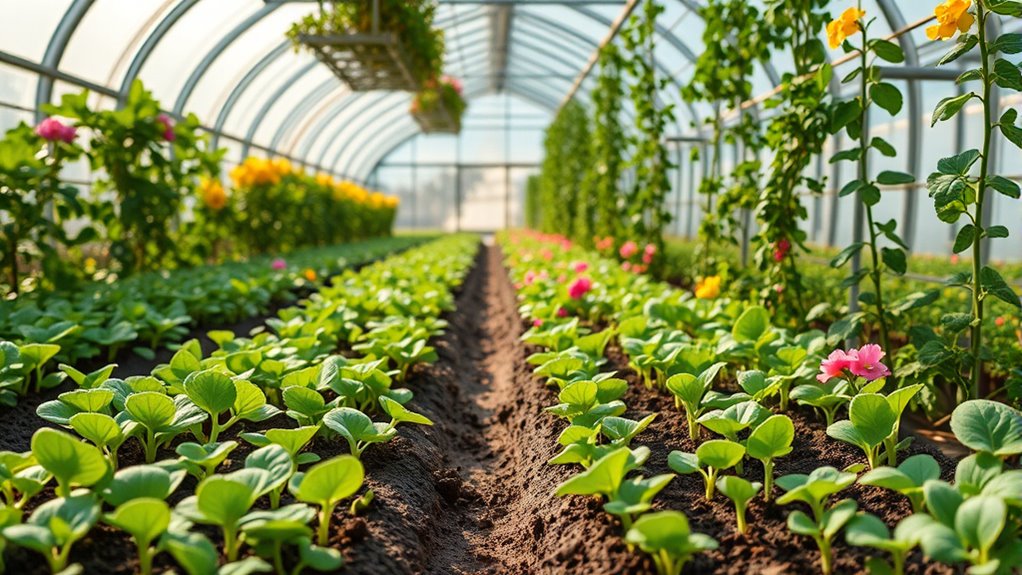
Greenhouse gardening offers a practical way to extend your growing season and cultivate plants regardless of outdoor weather conditions. When you’re looking to start seedlings, grow early vegetables, or enjoy vibrant flowers, a greenhouse provides the perfect environment. To maximize your results, investing in the right technology, like hydroponic systems and effective climate control, makes a significant difference. Hydroponic systems allow you to grow plants without soil, using nutrient-rich water solutions that deliver everything your plants need directly to their roots. This method accelerates growth, reduces pests, and allows you to control every aspect of your plants’ nutrition, making it ideal for early spring gardening. Climate control systems further enhance your greenhouse’s environment by regulating temperature, humidity, and airflow. With automated vents, heaters, and fans, you can maintain ideal conditions, preventing temperature swings that could stress your plants or hinder growth.
As you prepare your greenhouse for spring, setting up a hydroponic system can give you a head start on the growing season. You’ll see seedlings sprout faster and develop more robustly because they’re receiving precise nutrients tailored to their needs. Climate control ensures consistent warmth, especially during chilly mornings or unexpected cold snaps, so your seedlings won’t suffer from temperature shocks. It also helps maintain the right humidity levels, preventing diseases like mold or damping-off that can plague young seedlings. With these tools in place, you can start your planting schedule early, giving your vegetables, flowers, and herbs a longer period to thrive before outdoor conditions become suitable.
Growing early veggies like lettuce, spinach, or radishes becomes more manageable with controlled environments. You can adjust light exposure and temperature to mimic perfect outdoor conditions, even if the weather outside remains unpredictable. This flexibility allows you to harvest your greens sooner than traditional outdoor planting would permit. Plus, your flowers will benefit from stable conditions, leading to more vibrant blooms and fewer setbacks from sudden weather changes. The combination of hydroponic systems and climate control makes greenhouse gardening not only productive but also enjoyable, as you gain more control over your plants’ health and development.
In essence, by harnessing these technologies, you transform your greenhouse into a highly efficient, year-round growing space. Whether you’re starting seedlings, nurturing early veggies, or cultivating spring flowers, these tools give you the confidence and capability to succeed. As you get accustomed to managing climate and nutrient levels, you’ll discover how much easier it is to enjoy a continuous, rewarding gardening experience—no matter what the weather forecast says.
Furthermore, understanding the importance of Gold IRA options can help diversify your investment portfolio and provide financial security for the future.
Frequently Asked Questions
What Are the Best Lighting Options for Spring Greenhouse Seedlings?
When choosing grow light options for your seedlings, you should consider natural vs. artificial lighting. Natural sunlight is ideal, but if it’s limited, opt for full-spectrum grow lights that mimic sunlight. LED grow lights are energy-efficient and provide the right spectrum for healthy growth. Position your lights about 2-4 inches above seedlings and adjust as they grow to make certain they get enough light without overheating.
How Do I Prevent Pests in Early Spring Greenhouse Plants?
Imagine your greenhouse as a fortress, shielding your precious plants from pests. To keep invaders at bay, choose pest resistant varieties that stand strong like knights. Use natural deterrents such as neem oil or insecticidal soap, which act like invisible shields. Regularly inspect your plants and keep the environment tidy, so pests find no hiding spots. With these tactics, your greenhouse remains a safe haven for thriving, healthy plants.
What Temperature Range Is Ideal for Germinating Seeds Indoors?
For successful seed germination indoors, you should maintain a temperature range of 65-75°F. This is essential for seed starting tips and indoor germination techniques to work effectively. Keep your seeds in a warm, well-lit spot, avoiding drafts or temperature fluctuations. Use a heat mat if needed to guarantee consistent warmth. Proper temperature control helps seeds sprout quickly and develops strong seedlings, setting the stage for healthy plant growth.
How Often Should I Water Seedlings in a Greenhouse?
Imagine your seedlings as tiny explorers, enthusiastic for just the right amount of moisture. You should water them when the soil moisture feels dry to the touch, usually every 1-2 days. Keep a consistent watering schedule, avoiding overwatering which can drown roots, or underwatering that dries them out. Regularly check soil moisture to maintain a healthy environment, ensuring your seedlings thrive and grow strong.
Can I Grow Tropical Plants in a Spring Greenhouse?
Yes, you can grow tropical plants in a spring greenhouse if you focus on tropical plant care. Maintain high humidity levels with proper greenhouse humidity control, as tropical plants thrive in moist environments. Additionally, guarantee they receive adequate light and warmth. Keep an eye on temperature fluctuations and avoid drafts. With proper care, your tropical plants will flourish, adding lush greenery and vibrant colors to your greenhouse.
Conclusion
As you embrace greenhouse gardening this spring, you’ll enjoy the satisfaction of nurturing seedlings, vibrant flowers, and early veggies. Did you know that greenhouses can extend the growing season by up to 50%? With proper care, you’ll see your plants thrive earlier and longer. Keep experimenting and learning, and you’ll find your greenhouse becomes a lush, productive oasis. Happy gardening—your spring bounty awaits just beyond those glass walls!

